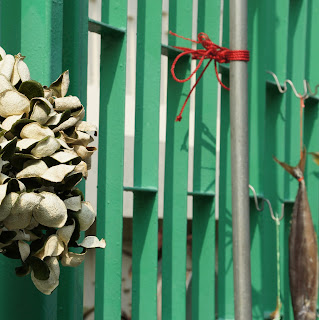Aromatic herbs and carnation leaves!
Before sharing my grand-mother's pesto and potato gnocchi recipes with you I would like to "tell" you a short story. Here it is:
Bouquet garni is commonly used in French cuisine. A typical bouquet garni is made of fresh parsley, thyme, and bay leaves. Other aromatic plants can also be included such as leek, celery, etc. depending on what you have in your kitchen and the season.
My mum uses freshly cut herbs from her garden. She spends a lot of time in her garden. Not only does she cultivate aromatic herbs to add flavours to her dishes but also herbs believed to have medicinal properties.
Every day she visits her garden to check if her plants are growing well. She grows basil, bay (du laurier sauce), chamomile, chives (de la ciboulette), mint, parsley (du persil), rosemary (du romarin), sage, sorrel (de l’oseille), thyme (du thym), tarragon (de l’estragon), and others.
However, one has to be careful in selecting plants for cooking! I recall a funny story. My sister loved to cook when she was a teen and always made us try new and delicious recipes. One day my parents found the dish had a peculiar taste but could not figure out why until they asked my sister where she went to get the sage required in her recipe. To our surprise we learnt that we had just tasted a carnation-flavoured sauce as she mistakenly used carnation leaves instead of sage. Luckily for us this plant is not toxic. As for its taste, I can’t recall it, which means it must not have been that bad!
Here in Hong Kong I always have dried thyme and bay leaves in my kitchen (that I bring back from France each summer) to make bouquet garni and also for my home-made vegetable broth. These are a few of my favourite herbs. Another important kitchen plant is sweet basil. This herb brings to mind summer time and Mediterranean-style food, such as pistou, pesto sauce, tomato & mozzarella salad, etc. Basil is not used frequently in traditional Cantonese cuisine although many other Asian countries add some sprigs into soups, salads and noodles dishes.
The two most commonly used aromatic herbs in Cantonese cooking are coriander and spring onion or scallion (la ciboule). These two plants are used for accent both in colour and taste.
Coriander, also called cilantro, is added in stir-fries at the last minute and gives a strong and pungent flavour. But the most popular aromatic plant is certainly scallion. It is present in nearly every dish and makes a nice garnish. Wet market sellers usually give you a few sprigs free of charge when you buy a few catties of vegetable or are a regular. The famous Cantonese-style steamed fish would not be what it is without thinly chopped spring onion. The fragrance of spring onion tossed in oil and sprinkled on top of the dish, as well as its flavour, are unique and simply awesome! miam miam.
Potato Gnocchi al Pesto
 |
My father pounding basil, parsley, garlic and
coarse salt in his mother's wooden mortar |
 |
Adding olive oil
Ingredients for pesto:
o 10g basil + 10g parsley
o 50g pine nuts
o 1 garlic clove
o 70ml olive oil
o 1 pinch salt
Steps:
Put all the above ingredients in the food processor. Pulse until obtaining a smooth paste.
Transfer paste into a glass jar. Cover with a little bit of olive oil and close lid tightly and store in fridge (can be stored for up to 1 month).
Note: Pesto ingredients were traditionally crushed into a cream with a mortar and pestle. The typical Pesto alla Genovese has grated hard cheese (parmesan) in.
Potato gnocchi is an Italian dish. Gnocchi are small balls of dough shaped into dumplings. They are made with potato and flour and cooked in boiling water. They are often served with a tomato sauce or better (to my liking) pesto sauce.
Shaping the gnocchi to make a concave shape requires some skills and speed. However, dumplings don’t have to be perfect and identically-shaped!
Ingredients for gnocchi:
350g potatoes (mashed through a sieve)
75g flour, plus extra for rolling out - sifted
2 tbsp vegetable oil
Salt and ground black pepper
Steps:
Bring a large pan of water to the boil. Add the potatoes and cook for 12-15 minutes or until tender (do not overcook). Drain and leave to cool.
Peel and then mash the potatoes. Add salt, pepper, and sifted flour. Mix together with your hands to form a smooth ball.
Flour a board and your hands. Roll the dough into a sausage (1.5 cm thick). Cut the sausage into 1.5 cm long pieces.
Press your index finger into each piece to create a concave shape OR Press each piece with a fork to make a series of ridges
Bring a large pan of water (w/ vegetable oil) to the boil and cook the gnocchi, in batches, for about 2 minutes. They should rise to the surface when cooked.
Drain and transfer in a serving bowl.
Spoon sauce on top (tomato, pesto or any sauce you like). You can also add grated cheese. Serve hot.
|
 |
| Chicken chasseur w/ potato gnocchi & sugar snap peas |
 |
| Gnocchi w/ tomato sauce |












































